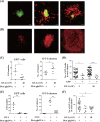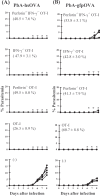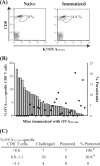CD8+ T cells specific for a malaria cytoplasmic antigen form clusters around infected hepatocytes and are protective at the liver stage of infection
- PMID: 23897612
- PMCID: PMC3811763
- DOI: 10.1128/IAI.00570-13
CD8+ T cells specific for a malaria cytoplasmic antigen form clusters around infected hepatocytes and are protective at the liver stage of infection
Abstract
Following Anopheles mosquito-mediated introduction into a human host, Plasmodium parasites infect hepatocytes and undergo intensive replication. Accumulating evidence indicates that CD8(+) T cells induced by immunization with attenuated Plasmodium sporozoites can confer sterile immunity at the liver stage of infection; however, the mechanisms underlying this protection are not clearly understood. To address this, we generated recombinant Plasmodium berghei ANKA expressing a fusion protein of an ovalbumin epitope and green fluorescent protein in the cytoplasm of the parasite. We have shown that the ovalbumin epitope is presented by infected liver cells in a manner dependent on a transporter associated with antigen processing and becomes a target of specific CD8(+) T cells from the T cell receptor transgenic mouse line OT-I, leading to protection at the liver stage of Plasmodium infection. We visualized the interaction between OT-I cells and infected hepatocytes by intravital imaging using two-photon microscopy. OT-I cells formed clusters around infected hepatocytes, leading to the elimination of the intrahepatic parasites and subsequent formation of large clusters of OT-I cells in the liver. Gamma interferon expressed in CD8(+) T cells was dispensable for this protective response. Additionally, we found that polyclonal ovalbumin-specific memory CD8(+) T cells induced by de novo immunization were able to confer sterile protection, although the threshold frequency of the protection was relatively high. These studies revealed a novel mechanism of specific CD8(+) T cell-mediated protective immunity and demonstrated that proteins expressed in the cytoplasm of Plasmodium parasites can become targets of specific CD8(+) T cells during liver-stage infection.
Figures






Similar articles
-
Nonspecific CD8+ T Cells and Dendritic Cells/Macrophages Participate in Formation of CD8+ T Cell-Mediated Clusters against Malaria Liver-Stage Infection.Infect Immun. 2018 Mar 22;86(4):e00717-17. doi: 10.1128/IAI.00717-17. Print 2018 Apr. Infect Immun. 2018. PMID: 29426043 Free PMC article.
-
Antigen export during liver infection of the malaria parasite augments protective immunity.mBio. 2014 Jul 29;5(4):e01321-14. doi: 10.1128/mBio.01321-14. mBio. 2014. PMID: 25073641 Free PMC article.
-
CD8+ T cells eliminate liver-stage Plasmodium berghei parasites without detectable bystander effect.Infect Immun. 2014 Apr;82(4):1460-4. doi: 10.1128/IAI.01500-13. Epub 2014 Jan 13. Infect Immun. 2014. PMID: 24421043 Free PMC article.
-
The role of intrahepatic lymphocytes in mediating protective immunity induced by attenuated Plasmodium berghei sporozoites.Immunol Rev. 2000 Apr;174:123-34. doi: 10.1034/j.1600-0528.2002.00013h.x. Immunol Rev. 2000. PMID: 10807512 Review.
-
Current Challenges in the Identification of Pre-Erythrocytic Malaria Vaccine Candidate Antigens.Front Immunol. 2020 Feb 21;11:190. doi: 10.3389/fimmu.2020.00190. eCollection 2020. Front Immunol. 2020. PMID: 32153565 Free PMC article. Review.
Cited by
-
A Peptide-Based PD1 Antagonist Enhances T-Cell Priming and Efficacy of a Prophylactic Malaria Vaccine and Promotes Survival in a Lethal Malaria Model.Front Immunol. 2020 Jul 9;11:1377. doi: 10.3389/fimmu.2020.01377. eCollection 2020. Front Immunol. 2020. PMID: 32733457 Free PMC article.
-
Antigen-driven focal inflammatory death of malaria liver stages.Front Microbiol. 2015 Feb 4;6:47. doi: 10.3389/fmicb.2015.00047. eCollection 2015. Front Microbiol. 2015. PMID: 25699034 Free PMC article.
-
Nonspecific CD8+ T Cells and Dendritic Cells/Macrophages Participate in Formation of CD8+ T Cell-Mediated Clusters against Malaria Liver-Stage Infection.Infect Immun. 2018 Mar 22;86(4):e00717-17. doi: 10.1128/IAI.00717-17. Print 2018 Apr. Infect Immun. 2018. PMID: 29426043 Free PMC article.
-
Antigen export during liver infection of the malaria parasite augments protective immunity.mBio. 2014 Jul 29;5(4):e01321-14. doi: 10.1128/mBio.01321-14. mBio. 2014. PMID: 25073641 Free PMC article.
-
The subcellular location of ovalbumin in Plasmodium berghei blood stages influences the magnitude of T-cell responses.Infect Immun. 2014 Nov;82(11):4654-65. doi: 10.1128/IAI.01940-14. Epub 2014 Aug 25. Infect Immun. 2014. PMID: 25156724 Free PMC article.
References
-
- Nussenzweig RS, Vanderberg J, Most H, Orton C. 1967. Protective immunity produced by the injection of X-irradiated sporozoites of Plasmodium berghei. Nature 216:160–162 - PubMed
-
- Hoffman SL, Doolan DL. 2000. Malaria vaccines-targeting infected hepatocytes. Nat. Med. 6:1218–1219 - PubMed
-
- Mueller AK, Labaied M, Kappe SH, Matuschewski K. 2005. Genetically modified Plasmodium parasites as a protective experimental malaria vaccine. Nature 433:164–167 - PubMed
Publication types
MeSH terms
Substances
LinkOut - more resources
Full Text Sources
Other Literature Sources
Molecular Biology Databases
Research Materials

